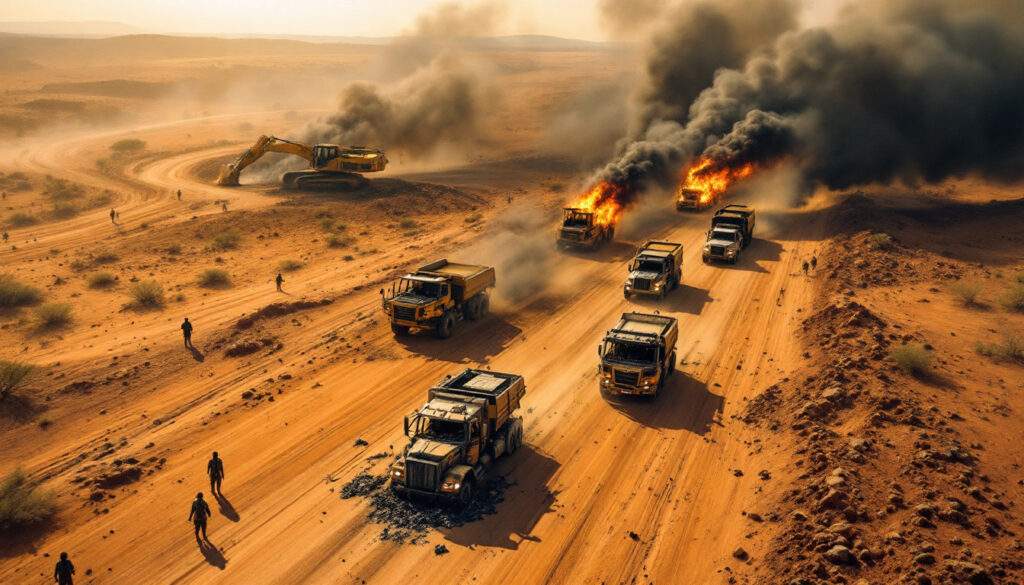Mining Convoy Attack in Mali: Escalating Security Threats for Mining Operations
In a concerning development for the mining sector in West Africa, armed assailants targeted a convoy transporting mining equipment in Mali's Kayes region, highlighting the growing security challenges faced by mining companies operating in the Sahel. This incident represents a troubling shift in the security landscape, as mining operations—previously considered less likely targets—now appear increasingly vulnerable to attacks in a region already struggling with widespread insecurity.
What Happened During the Mali Mining Convoy Attack?
The attack occurred on Sunday, May 5, 2024, between the towns of Diema and Sandare in Mali's western Kayes region. A convoy transporting heavy mining equipment from Bamako, Mali's capital, to Allied Gold's Sadiola mine was ambushed by unidentified attackers. Two large trucks were set ablaze, an excavator sustained significant damage, and two pickup trucks were stolen during the assault.
The equipment belonged to Neemba, the local Caterpillar dealer in Mali, and had been leased to Mota-Engil, a subcontractor working for Allied Gold at the Sadiola mine. Eight Neemba employees were present during the attack but fortunately escaped unharmed when Malian army soldiers, who happened to be stationed nearby, intervened and disrupted the assault.
"The swift response of the Malian soldiers prevented what could have been a much more severe outcome," noted a security consultant who requested anonymity due to the sensitivity of the situation. "The attackers fled once military personnel arrived on the scene."
As of the reporting date, no group has claimed responsibility for the incident, leaving authorities and mining companies uncertain about the specific motivation behind the attack.
The Kayes region, where the incident took place, has historically been considered one of Mali's more stable areas compared to the volatile central and northern regions of the country. This attack represents a concerning geographic expansion of security threats into areas previously deemed relatively safe for commercial operations.
How Does This Attack Reflect Broader Security Concerns in Mali?
The targeting of mining equipment and infrastructure marks a notable shift in the security landscape of Mali. Until recently, attacks on mining operations and their supply chains were relatively uncommon, with militant groups primarily focusing on government, military, and civilian targets.
"We're seeing a concerning evolution in targeting patterns," explains Dr. Ibrahim Maiga, a regional security analyst with the Institute for Security Studies. "Economic infrastructure, particularly foreign-owned mining operations, may be increasingly viewed as legitimate targets by armed groups seeking to weaken the state's financial resources or demonstrate their reach."
This attack follows a more severe incident in February 2024 when three employees of B2Gold were killed after their convoy was attacked in central Mali. Sources familiar with that incident indicated the B2Gold vehicles may have been mistaken for military transport, highlighting the precarious situation for any vehicle movements in certain regions.
The security context in Mali has deteriorated significantly despite promises from the military government that seized power in a 2021 coup to improve safety and combat terrorism. Mali is part of the wider Sahel region facing persistent and growing threats from various armed groups, including jihadist organizations affiliated with Al Qaeda (notably Jama'at Nusrat al-Islam wal-Muslimin, or JNIM) and Islamic State in the Greater Sahara (ISGS).
Mali, Burkina Faso, and Niger have all experienced military coups in recent years (Mali in 2021, Burkina Faso in 2022, and Niger in 2023), with military leaders justifying their takeovers partly on the failure of previous governments to address the security crisis. Despite these transitions and promises to counter jihadist threats more effectively, insecurity continues to plague all three countries, with some experts suggesting the situation has worsened.
"The security landscape in the Sahel has transformed dramatically in the past five years," notes West Africa researcher Hannah Armstrong. "Areas once considered stable are now experiencing regular security incidents, and the geographic reach of armed groups continues to expand despite changes in government."
Mining operations across the region increasingly face significant challenges in securing transportation routes, protecting staff, and maintaining regular operations amidst the deteriorating security environment.
What Are the Implications for Mining Companies in the Region?
The attack on the mining convoy in Mali underscores the growing operational challenges for mining companies in Mali and the broader Sahel region. These security threats translate directly into increased costs, operational disruptions, and strategic reconsiderations for companies with assets in the region.
Operational and Financial Impacts
Mining companies operating in Mali now face:
- Escalating security expenditures: Companies must invest in enhanced security protocols, including armored vehicles, security personnel, and advanced monitoring systems.
- Transportation challenges: Moving equipment, supplies, and produced minerals has become increasingly hazardous, requiring additional planning and security measures.
- Rising insurance premiums: Insurance companies have responded to the deteriorating security situation by raising premiums for operations in high-risk regions, with some policies now including specific "terrorism risk" surcharges.
- Production delays: Security incidents can lead to temporary shutdowns or slowdowns in production, affecting output targets and financial performance.
- Personnel safety concerns: Companies face greater difficulty in recruiting and retaining skilled expatriate workers willing to accept positions in high-risk environments.
"The added security costs can increase operational expenses by 15-25% compared to similar operations in more stable jurisdictions," estimates mining analyst Pierre Fournier. "This creates a significant competitive disadvantage and may render some marginal deposits uneconomic."
Corporate Responses to Security Threats
Companies are responding to these challenges in various ways:
- Enhanced security protocols: Implementation of advanced tracking systems, convoy protocols, and coordination with local security forces.
- Strategic reassessment: Some companies are reconsidering their presence in the region altogether.
- Community engagement: Increased investment in local community relations to build support networks that may provide early warning of potential threats.
- Diversification: Companies with multiple assets are working to reduce their proportional exposure to high-risk regions.
Canadian gold miner Fortuna Silver Mines recently decided to exit neighboring Burkina Faso, citing increased security concerns as a contributing factor to their strategic repositioning. This decision highlights the difficult calculus companies face when weighing Mali's mineral potential against substantial risk management red flags.
Companies still operating in Mali include several major players in the gold mining sector, such as Barrick Gold, B2Gold, Resolute Mining, Endeavour Mining, and Hummingbird Resources. These companies must continually evaluate the balance between security risks and Mali's significant gold resources while negotiating additional security arrangements with local authorities.
"For established operations with significant sunk costs, the calculus is different than for companies considering new investments," explains mining executive Jean Dupont. "Existing operators may accept higher security costs as part of the business model, while new entrants might direct their exploration dollars to less volatile jurisdictions."
What Makes Mali a Strategic Mining Location Despite the Risks?
Despite the growing security challenges, Mali remains a highly attractive jurisdiction for mining companies due to its exceptional mineral endowment, particularly in gold.
Mali's Mining Significance
Mali ranks among Africa's top three gold producers, behind only Ghana and South Africa. The country's western and southern regions are particularly gold-rich, hosting world-class deposits along the Mali-Senegal shear zone and other geologically favorable structures within the West African Craton. These Birimian-age greenstone belts have proven exceptionally productive for gold discoveries.
The Sadiola mine, operated by Allied Gold (previously owned by AngloGold Ashanti and IAMGOLD), represents one of Mali's flagship gold operations, having produced over 7 million ounces of gold since operations began in the 1990s. Recent expansion projects aim to extend the mine's life by tapping into deeper sulfide ores beneath the originally mined oxide deposits.
Gold mining constitutes approximately 7% of Mali's GDP and accounts for over 70% of the country's export earnings, making it vital to the national economy. This economic importance partly explains why mining operations have continued despite increasing security challenges—both mining companies and the Malian government have strong incentives to maintain production.
Risk vs. Reward Assessment
Mining companies conducting business in Mali engage in complex risk-reward calculations that consider:
- Geological potential: Mali's exceptional gold endowment provides a compelling reason to accept higher operational risks.
- Existing infrastructure: Companies with established operations have already made substantial capital investments that would be difficult to replicate elsewhere.
- Comparative risk: While security threats in Mali are significant, other mining jurisdictions present different challenges, including political instability, resource nationalism, or poor infrastructure.
- Cost structure: Despite security premiums, Mali's operations can still deliver competitive production costs due to favorable ore grades and relatively simple metallurgy.
- Community relationships: Many mining companies have built strong local relationships over decades of operation, providing some buffer against certain security risks.
"You have to view these investments through a long-term lens," says resource investor Marc Sonnier. "Gold mining is inherently high-risk globally, and companies develop expertise in managing various types of risk. Security challenges are just one factor in a complex equation that includes geological, political, and economic considerations."
How Are Security Challenges Affecting the Broader Mining Industry in West Africa?
The security situation in Mali exists within a wider regional context, with varying impact across West Africa's mining sector.
Regional Industry Trends
Security concerns are reshaping investment decisions across the entire Sahel region, with several notable industry evolution trends emerging:
- Investment redirection: New exploration dollars increasingly favor coastal West African countries (Ghana, Côte d'Ivoire, Senegal) over Sahelian states (Mali, Burkina Faso, Niger).
- Consolidated ownership: Smaller mining companies with limited security resources are selling assets to larger operators better equipped to manage elevated risks.
- Supply chain adaptation: Companies are developing redundant supply routes and local sourcing options to reduce vulnerability to transportation disruptions.
- Community impact: Local communities near mining operations face dual pressures from armed groups and reduced economic activity when operations scale back.
- ESG complications: Companies face increasing difficulty in meeting environmental, social, and governance commitments in high-risk environments where access to project sites may be limited.
These trends have accelerated since 2020, with the COVID-19 pandemic initially complicating security arrangements and subsequent political instability further challenging operations.
Comparative Security Situations
Security risks vary significantly across West African mining jurisdictions:
| Country | Security Risk Level | Key Concerns | Mining Investment Trend |
|---|---|---|---|
| Mali | High | Jihadist groups, military coup aftermath | Decreasing for new projects |
| Burkina Faso | Very High | Widespread militant activity, limited government control | Significant divestment |
| Niger | High | Growing jihadist presence, political uncertainty | Stalled development |
| Ghana | Low-Moderate | Limited to criminal activities, isolated regions | Strong continued interest |
| Côte d'Ivoire | Moderate | Northern border threats, occasional unrest | Increasing investment |
| Senegal | Low-Moderate | Casamance separatists, northern border concerns | Growing exploration |
"The security gradient from coastal to Sahelian states is increasingly pronounced," observes regional security consultant Mohammed Diallo. "This is reshaping the mining investment map of West Africa, with coastal nations capturing investment that might previously have flowed to Mali or Burkina Faso."
Regional security cooperation efforts, including the G5 Sahel initiative and various international military assistance programs, have shown limited effectiveness in protecting economic infrastructure, leaving mining companies largely responsible for their own security arrangements.
What Security Measures Can Mining Companies Implement?
Mining companies operating in Mali and similar high-risk environments have developed increasingly sophisticated security approaches to protect personnel, assets, and operations.
Enhanced Protection Strategies
Effective security measures now commonly include:
- Armored transportation: Specially modified vehicles with ballistic protection for personnel movements
- Military coordination: Formal arrangements with Malian armed forces for convoy escorts during critical shipments
- Advanced monitoring: Satellite tracking systems for all vehicles and equipment, with real-time monitoring and geofencing alerts
- Intelligence networks: Dedicated security teams gathering information about potential threats before any convoy movements
- Rapid response protocols: Comprehensive emergency procedures for various attack scenarios, including medical evacuation plans
"The sophistication of security operations at major mining companies now rivals that of many military units," notes security consultant Jean-Paul Masimba. "The largest operators maintain dedicated intelligence teams and security operations centers monitoring movements 24/7."
Risk Mitigation Approaches
Beyond physical security measures, companies employ broader strategic approaches:
- Community engagement programs that build information networks and local support
- Unpredictable scheduling of equipment and supply movements to reduce targeting opportunities
- Smaller convoy configurations that attract less attention and present less valuable targets
- Strategic stockpiling of critical supplies to reduce transportation frequency
- Alternative transportation methods, including consideration of air transport for high-value items despite higher costs
"Smart companies understand that security isn't just about guns and guards," explains community relations specialist Aminata Touré. "Building genuine relationships with local communities often provides the best intelligence and creates a network of stakeholders invested in the operation's security."
The most effective security strategies combine physical protection measures with intelligence gathering, community engagement, and operational adaptability. Companies that integrate security considerations throughout their business planning rather than treating it as an add-on function typically achieve better outcomes in high-risk environments.
FAQs About Mining Security in Mali
Are mining companies leaving Mali due to security concerns?
While some companies have reduced their exposure to the region—notably Fortuna Silver Mines exiting neighboring Burkina Faso—most major mining firms continue operations in Mali despite the challenges. Companies with established operations and significant invested capital typically choose to enhance security rather than abandon productive assets. However, new exploration investment has declined noticeably, with companies directing early-stage projects to jurisdictions with more favorable risk profiles.
How do mining attacks in Mali compare to other security incidents in the region?
Mining-related attacks remain less common than attacks on government or military targets in Mali. However, the recent incidents suggest mining operations may face increased targeting, either deliberately or through mistaken identity with military convoys. The mining convoy attack pattern appears to be evolving, with previous incidents focused primarily on personnel transport and the recent attack targeting equipment and infrastructure. This potentially indicates a strategic shift from attempting to maximize casualties to disrupting economic activity.
What role does the Malian government play in securing mining operations?
The military-led government in Mali has pledged to improve security, but effectiveness varies considerably by region. Mining companies typically negotiate specific security arrangements, sometimes including military escorts for important transports. However, these arrangements create their own complications, as association with government forces can make companies targets for anti-government groups. Additionally, the withdrawal of international forces previously supporting counter-terrorism operations has placed greater pressure on Mali's military, potentially reducing resources available to protect mining operations.
How do security concerns affect gold production in Mali?
While Mali remains one of Africa's top gold producers, security concerns add operational costs and complications that impact production efficiency. Companies must invest in additional security measures, potentially diverting resources from production expansion. Transportation disruptions can delay equipment deliveries and consumable supplies, affecting production schedules. Some companies have reported production interruptions during periods of heightened security threats, though most major operations maintain output targets through enhanced haulage safety protocols and contingency planning.
What are the warning signs of deteriorating security for mining operations?
Key indicators include increased frequency of attacks on transportation routes, expanding geographic range of militant activities, targeting of previously secure areas, and intelligence reports of changing militant tactics specifically targeting economic infrastructure. Mining companies maintain sophisticated monitoring systems to track these indicators, often sharing information through industry security networks while maintaining appropriate confidentiality. Early warning signs that preceded the recent escalation included increased checkpoint activity by non-state actors and a rise in smaller criminal incidents along key transportation corridors.
Further Exploration
The security situation affecting mining operations in Mali continues to evolve, requiring ongoing monitoring and analysis. Companies, investors, and policy analysts tracking the West African mining sector should maintain awareness of both security developments and their potential impact on mineral production, investment flows, and regional stability.
The mining convoy attacked in Mali represents not just an isolated security incident but a potential indicator of broader shifts in the regional risk landscape that may require adaptive responses from both companies and governments with economic interests in the region. Despite these challenges, African mining opportunities remain significant, and operators continue to adapt to the evolving security situation while monitoring mining disruptions in Africa more broadly.
Want to Spot the Next Major Mineral Discovery Before the Market?
Discover how you can identify significant ASX mineral discoveries before they hit the headlines with Discovery Alert's proprietary Discovery IQ model. Visit our discoveries page to explore how early alerts on major finds like De Grey Mining have delivered exceptional returns for proactive investors.




